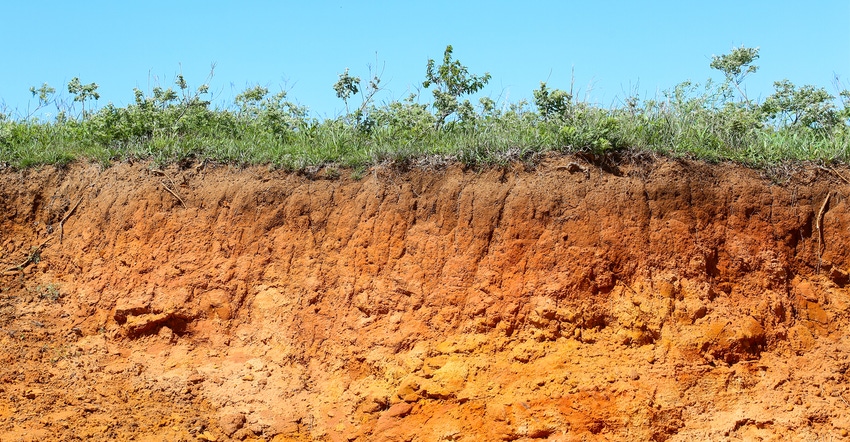
“We don’t realize just how productive we could be if we just built our topsoil back,” Josh Lloyd says.
Lloyd, who farms near Clay Center, Kan., shared his work in rebuilding his family farm’s topsoil and the economic returns from that investment of time at the 2022 No-till on the Plains annual conference on Jan. 25.
Kansas is a land that was shaped by retreating glaciers thousands of years ago. In their wake, they left parent materials of sand, silt and clay, Lloyd explains. Then, over the following centuries, nature built rich, productive topsoil by depositing layer after layer of organic material from plants and animals.
In the last century, though, farmers disrupted that cycle by tilling that topsoil, losing much of it to erosion, until now farmers are back to that less productive parent material of sand, silt and clay.
“We’re just farming the geology of the sand, silt and clay when we should be farming the biology,” Lloyd says.
Dollars and cents
Farming the biology just makes “cents,” Lloyd says.
He gave the example that on his family’s farm, there used to be a feedlot where the Lloyds backgrounded steers. Over 50 years, hay, feed grains and manure were deposited naturally on that square of ground. Across the fence line, though, the family had been farming with tillage for decades and applying nitrogen, phosphorus and potassium.
Grid sampling both parcels, Lloyd says the organic matter from the former feedlot is almost three times that of the former tilled crop land. That organic matter is feeding microbes and cycling nutrients better, resulting in more fertile, natural reserves of soil organic matter nutrients. And that saves the farm money.
“Assuming 2 million pounds of soil on the top six inches, and 1% organic matter, that equals to 20,000 pounds [of soil organic matter nutrients],” Lloyd says. At today’s prices, if you were to purchase and apply those nutrients, it would equal $900’ worth of nitrogen, $70 of phosphorus, $40 of potassium, $50 of sulfur and $20 of carbon, for a total per acre of $1,080.
“This is just looking at the top 6 inches,” he says. “This isn’t even accounting for in our native topsoil, where it’s a lot deeper than 6 inches.”
How do you get there?
Rebuilding topsoil takes time, and planning, Lloyd says. He uses a five-year crop rotation of winter wheat, double-crop soybeans, cover crops, corn, sorghum, and rye. This rotation meets his three goals of sticking to no-till, avoiding fallow and planting with carbon diversity in mind.
His tips include:
1. After summer harvest either plant a second cash crop, a cover crop, or a grazing crop.
2. Use cover crops to build soil, reduce herbicide costs, or as forage for livestock.
3. Use perennial forages for livestock grazing, and to diversify organic matter returning to the soil.
4. Graze livestock on baled hay to import carbon and nutrients to your pastures.
5. Plant rye in the fall for spring grazing. Then, plant soybeans into that green rye cover crop to provide weed control.
Rye’s multiple roles
Rye cover plays a big role in his overall topsoil building scheme, and it pays for itself. Chemical weed control, starting in the fall, costs about $48 an acre, he says, and there are no added benefits. The cost to seed rye, however, is about $35 per acre. That rye, he says, provides weed control, builds his topsoil and gives him about a ton of feed for livestock — worth roughly $85 a ton.
“That’s a $50 profit, versus a $50 loss,” he says.
By not terminating his rye, Lloyd says he also gets an even seedbed to plant soybeans.
The value of water
Clay Center typically gets about 31 inches of water a year, Lloyd says. That rainfall has a value to your crop budget of about $20 per inch of precipitation, he says. Letting ground lie fallow instead of having a green crop growing and doing something with that water can be expensive to the overall bottom line.
“If we left a field fallow from wheat harvest until we plant it to corn, we waste 11.84 inches of rainfall that could be working for us,” Lloyd says. That’s a loss of $236 just for the water. And while that money doesn’t come directly from his checkbook, it is a missed opportunity.
“You’re letting that ground sit fallow for almost a year, where you could have grown something,” he adds. And that could have brought income from a double cash crop, or income from a cover crop or a forage crop for grazing.
Livestock component
Lloyd has 65 head of cows and a 500-head flock of hair sheep that are his partners in building topsoil. He uses them to graze perennial crops — a return to the natural cycle of building organic matter.
He also adds to the organic matter of that pasture by importing carbon to the pasture in the form of baled hay from the farm’s waterways — which, over the decades, have caught the topsoil and fertilizer runoff from the Lloyds’ tilled fields and are lush with organic matter.
“We set out those bales and graze them,” Lloyd says. “A 1-ton bale contains about $75 in fertility, plus carbon and microbes. By bale grazing, we’re growing and supercharging that soil by keeping something on it all the time. And we’re importing carbon and nutrients to build it faster.”
Ultimately, to rebuild topsoil and grow your own fertility, it takes working with nature’s cycle instead of disrupting it. And that, Lloyd says, is how farmers can find more profit from every acre.
About the Author(s)
You May Also Like






